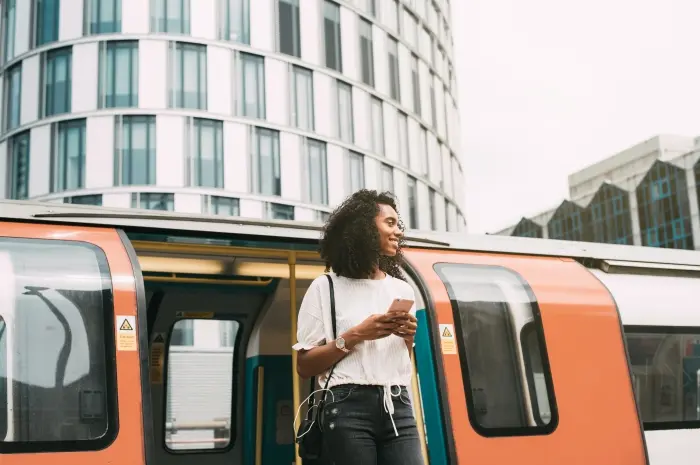Master the art of stress-free travel with our comprehensive guide on navigating London’s public transport system, featuring tips, tricks, and essential information.
Navigating public transport in London might seem daunting due to its vastness and complexity. However, with the right knowledge and tools, moving around the city can be straightforward and stress-free.
London’s public transport network, one of the world’s largest, includes the London Underground (Tube), buses, trams, river services, light railways, and national rail services.
This article provides practical advice on how to efficiently use these options, ensuring a smooth and pleasant journey across London.
1. Understanding the London Underground
The London Underground, commonly known as the Tube, is often the fastest way to get around the city. Familiarize yourself with the Tube map, which clearly marks all lines and stations. Each line has a unique color, making it easier to follow routes.
The Tube operates from early morning until around midnight, and there’s also a Night Tube service on certain lines on Friday and Saturday nights.
Start by planning your route using the Transport for London (TfL) journey planner or apps like Citymapper, which can help you navigate the network like a local.
2. Making Use of the Iconic Bus Network
London’s red double-decker buses are not only a city icon but also a practical way to travel. Buses cover routes that are not accessible by the Tube and offer a scenic view of the city.
Live bus arrivals and route maps can be accessed via the TfL website or through various mobile apps. Remember, you cannot pay with cash on buses; you must use an Oyster card, a contactless payment card, or a mobile payment app. Night buses run throughout the week, which is particularly useful when the Tube is closed.
3. Leveraging Contactless and Oyster Cards
For convenient payment across all forms of public transport in London, use an Oyster card or a contactless debit or credit card. You can purchase an Oyster card online before your trip or from Tube station ticket machines on arrival.
Topping up your card is straightforward, with machines available in all Tube stations and many convenience stores.
Both payment methods use a fare-capping system, ensuring you never spend more than the daily travelcard rate, making it a cost-effective option for multiple journeys.
4. Exploring with River Services
The River Thames offers alternative transport routes via river buses, which are a scenic and less crowded way to travel. Services like the Thames Clippers provide regular routes that connect key London destinations, including Greenwich, Canary Wharf, and Westminster.
These services are not only functional but offer a unique view of the city from the water. Tickets can be purchased at piers or charged to your Oyster or contactless card.
5. Utilizing the Docklands Light Railway (DLR) and Trams
The DLR serves parts of East and South East London, including areas near the River Thames and the London City Airport. It’s driverless, offering an interesting perspective from the front or back.
Trams, on the other hand, operate mainly in South London. Both are integrated with the Oyster and contactless systems, making them easy to access with the same payment methods used for other public transport.
6. Connecting via Overground and National Rail Services
The Overground network complements the Tube and covers areas beyond Central London, while National Rail services can be used to reach suburbs and other UK cities.
When traveling to destinations like Richmond, Watford, or Greenwich, these options can be more convenient than the Tube. Ensure to check whether your Oyster card covers these journeys, as some National Rail routes require a separate ticket.
7. Cycling and Walking for Shorter Journeys
For shorter distances, consider walking or using the Santander Cycles hire scheme. Walking can sometimes be faster than other modes of transport, especially during peak hours.
For cycling, hire a bike from numerous docking stations across the city and enjoy the first 30 minutes free. Both walking and cycling offer a healthy, flexible, and environmentally friendly way to explore the city.
8. Managing Peak Times and Avoiding Crowds
London’s public transport can get extremely busy during peak hours (6:30-9:30 AM and 4:00-7:00 PM on weekdays). If possible, plan your travel outside these times to enjoy a more comfortable journey.
Also, try to avoid major interchange stations like Oxford Circus or Bank during these periods if looking for a less crowded experience.
9. Staying Informed with Real-Time Travel Updates
Stay updated with real-time travel information to avoid unexpected delays or closures. TfL’s website, mobile apps, and electronic information boards at stations provide up-to-the-minute details about service changes, line closures, and maintenance works. This information can help you make informed decisions and find alternative routes if necessary.
10. Respecting Rules and Local Etiquette
Finally, understanding and respecting local travel etiquette can make your journey smoother and more enjoyable.
This includes standing on the right on escalators, allowing passengers to alight from vehicles before boarding, and using quiet zones appropriately. Being considerate of other passengers ensures a pleasant experience for everyone involved.
Navigating London’s public transport system efficiently requires a bit of preparation and knowledge but can be mastered with ease using the tips provided.
Whether you choose the speed of the Tube, the scenic routes by river, or the expansive reach of buses, London’s network is designed to get you to your destination in the most convenient way possible.
With the right tools and understanding, you can explore London stress-free, making the most of what this vibrant city has to offer.




